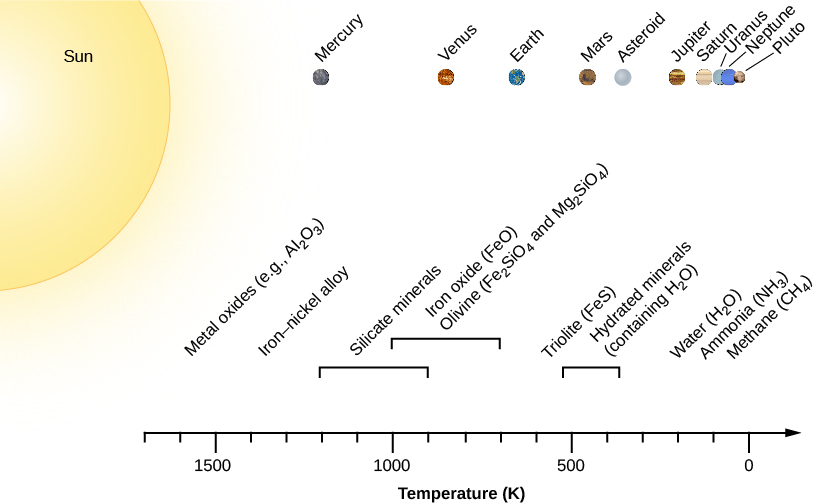| << Chapter < Page | Chapter >> Page > |
The temperature within the disk decreased with increasing distance from the Sun, much as the planets’ temperatures vary with position today. As the disk cooled, the gases interacted chemically to produce compounds; eventually these compounds condensed into liquid droplets or solid grains. This is similar to the process by which raindrops on Earth condense from moist air as it rises over a mountain.
Let’s look in more detail at how material condensed at different places in the maturing disk ( [link] ). The first materials to form solid grains were the metals and various rock-forming silicates. As the temperature dropped, these were joined throughout much of the solar nebula by sulfur compounds and by carbon- and water-rich silicates, such as those now found abundantly among the asteroids. However, in the inner parts of the disk, the temperature never dropped low enough for such materials as ice or carbonaceous organic compounds to condense, so they were lacking on the innermost planets.

Far from the Sun, cooler temperatures allowed the oxygen to combine with hydrogen and condense in the form of water (H 2 O) ice. Beyond the orbit of Saturn, carbon and nitrogen combined with hydrogen to make ices such as methane (CH 4 ) and ammonia (NH 3 ). This sequence of events explains the basic chemical composition differences among various regions of the solar system.
With P initial equal to 1,000,000 years, P final , the new rotation period, is 64 years. This is a lot shorter than the actual time Pluto takes to go around the Sun, but it gives you a sense of the kind of speeding up the conservation of angular momentum can produce. As we noted earlier, other mechanisms helped the material in the disk lose angular momentum before the planets fully formed.
The period of the rotating nebula is inversely proportional to D 2 . As we have just seen, Initially, we have P initial = 10 6 yr and D initial = 10 4 AU. Then, if D final is in AU, P final (in years) is given by If Jupiter’s orbit has a radius of 5.2 AU, then the diameter is 10.4 AU. The period is then 1.08 years.

Notification Switch
Would you like to follow the 'Astronomy' conversation and receive update notifications?